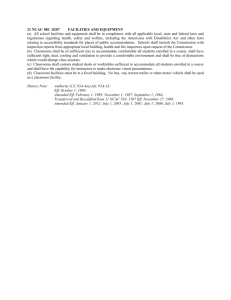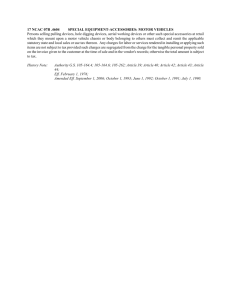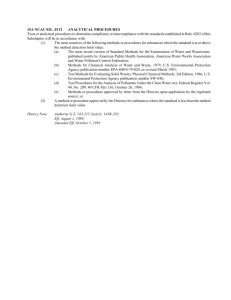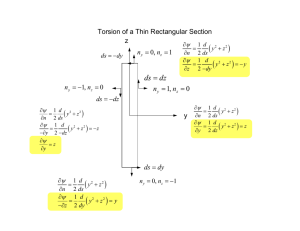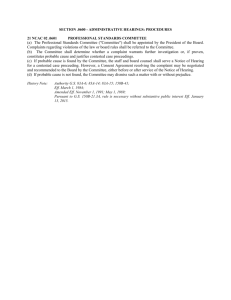Φ ( ) σ φ
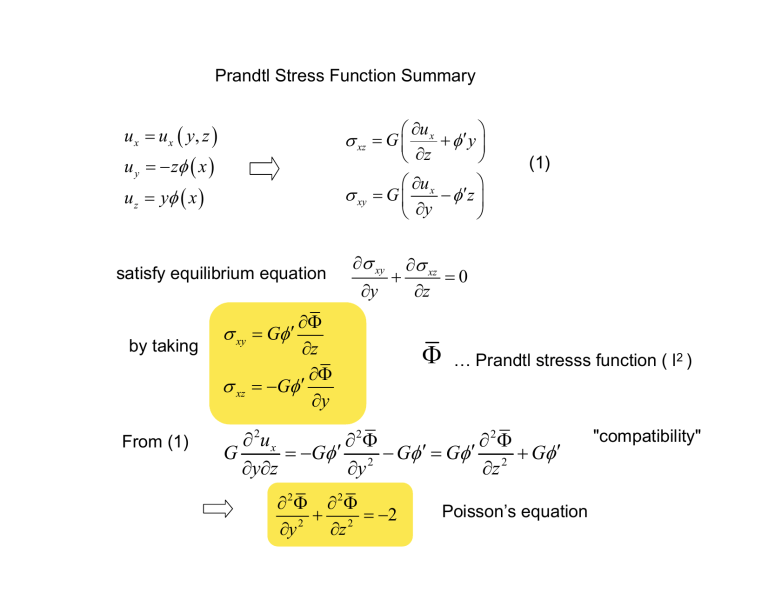
Prandtl Stress Function Summary u x
= u x
( ) u y
= − z
φ ( ) u z
= y
φ ( )
σ xz
σ xy
=
G
⎝
∂ u x
∂ z
=
G
⎛
⎝
∂ u x
∂ y
+ φ ′ y
⎠
− φ ′ z
⎞
⎠
(1) satisfy equilibrium equation by taking
From (1)
∂ σ
∂ y xy +
∂ σ
∂ z xz
=
0
σ xy
σ xz
=
G
φ ′
= −
G
φ
∂Φ
′
∂ z
∂Φ
∂ y
Φ
… Prandtl stresss function ( l 2 )
G
∂ 2 u x
= −
G
φ ′
∂ y
2
−
G
φ ′ =
G
φ ′
∂ z
2
+
G
φ ′
∂ y
2
2
∂ z
2
= −
2 Poisson’s equation
"compatibility"
∂ y
2
2
∂ z
2
= −
2 in A
σ xn
= σ n xy y
+ σ n xz z
=
G
φ ′ d
Φ ds
=
0
Φ = constant
=
0 on C bar cross section
T
A
C s n t
Torque-twist
T
= φ ′
eff on C
=
T
J eff
⎛ ∂Φ ⎞
⎝ ∂ n
⎟ on C
J eff
=
2
∫∫
Φ dA
(
τ
max
) on C
=
T
J eff
⎛ ∂Φ ⎞
⎝ ∂ n max on C
For the warping displacement t
∂ u x
∂ z
∂ u x
∂ y
= − φ ′ y
− φ ′
∂Φ
∂ y
= φ ′ z
+ φ ′
∂Φ
∂ z u x
= − φ ′
⎛
⎝ yz
+ ∫
∂Φ
∂ y dz
⎞
⎠
= φ ′
⎛
⎝ yz
+ ∫
∂Φ ⎞
∂ z dy
Thin rectangular cross section (neglect ends) z ⎛ t 2
Φ = −
4 y
2
⎞
⎠
J eff
=
2 y
=+ t
∫ y
=− t
/ 2
/ 2
Φ =
1 bdy bt
3
3 y
τ max
=
T
J eff
⎛
⎝
∓
∂Φ
∂ y
⎞
⎠ y
=± t / 2
=
3 T bt
2 u x
=
φ
′
yz
⎛
⎜ t 2
Φ = −
4 y
2
⎞
⎠ s
Membrane Analogy
∂ 2
∂ y w
2
+
∂
∂
2 z w
2
= − p s p w
Φ =
2 s w p s w
=
0 on the boundary
or
For cross sections with holes we also need to satisfy
∫ hole du
= x
0
Φ =
0
∫
hole
⎛ ∂Φ ⎞
⎝ ∂ n ds
=
2
φ
′ hole
Φ =
K
∫
hole
τ ds
=
2
φ ′ hole additional unknown supplementary condition to determine K
If one has multiple holes, this additional condition is applied at each hole to solve for the multiple unknown constants
Torsion of Thin, Closed Sections
τ a a a
K
1 b b
K
2 c
τ b
τ c c a
Φ
= K
1
Φ
= 0 a
Φ
= K
1
Φ
= K
2 b b t a
τ a
=
K
1 t a
, t b
τ b
=
K
1
−
K
2 t b
,
Φ
= K
2 c t c
τ c
=
K
2 t c c
q
1
= K
1 q
1 q
2 q
2
= K
2 shear flows q
1
= τ t a a
=
K
1
, q
= −
1 q
2
= τ t b b
=
K
1
−
K
2
, q
2
= τ t c c
=
K
2 shear flows into or out of a junction are conserved q
1
-q
2 q - q
2 1
∑
q out
=
0
q
1
= K
1
Ω
1
Ω
2 q
1 q
2 q
2
= K
2
Ω
i
… area enclosed by centerline of ith "cell'
Torque-shear flow for each cell
T
=
∑
i
2 q i
Ω i
∫
hole
τ ds
=
2
φ ′ hole
2 G
1
Ω
∫
i ith cell t q ds
=
φ
′
τ max
⎛
K q
⎞
⎝ t
⎠ max warping is generally small for closed sections
cell 1 q
1
Torsion of a Thin Closed Section
(multiple cells) q
2 cell 2
T 2
2 q
2
φ
′ =
1
2 G
Ω
1 C
1
∫ t q ds
φ
′ =
1
2 G
Ω
2 C
2
∫ t q ds
(1)
(2)
(3)
( the q in Eqs.(2) and (3) is the total q flowing in a given cross section, i.e it is q in the vertical section)
1
– q
2 flowing
1. If the torque T is known, then q
1 and q
2 are first found in terms of the unknown
φ
' from Eqs. (2) and (3). These q m
's are then placed into Eq.(1) which is solved for the unknown
φ
' . Once
φ
' is known in this manner, the q m
's are completely determined.
2.
If
φ
' is known, Eqs.(2) and ( 3) can be solved directly for the q m
's and then Eq.(1) can be used to find the torque, T
For a single cell, we can write these more explicitly
Ω
= area contained within the centerline of the cross section q r
⊥
P
T
T
= qr ds
C
∫
= q r ds
=
2 q
Ω
C
∫
φ ′ =
2
1
G
Ω
∫
C t q ds
=
T
4 G
Ω 2
∫
C ds t q
=
T
2
Ω
T
=
GJ eff
φ ′ where
J eff
=
4
Ω 2
∫
C ds t
τ max
=
⎛
T
⎞
⎝
2
Ω t
⎠ max
=
T
2
Ω t min
(no stress concentrations)
Torsion of a Thin Closed Section
(single cell)
Ω
= area contained within the centerline of the cross section q
=
T
2
Ω
(1) q r
⊥
T
P
T
=
GJ eff
φ ′ where
(2)
J eff
=
4
Ω 2
∫
C ds t
1. If T is known, q follows directly from Eq. (1),
φ
' is found from Eq.(2)
2. If
φ
' is known, T follows from Eq.(2), and q is then found from Eq. (1)
Torsion of a Thin Closed Section
(single cell)
The shear stress is not quite uniform across the thickness for thin closed sections yields uniform stress t
The difference looks much like that for an open section t so as a small correction factor:
J eff
=
4
Ω 2
∫
C ds t
+
1
3
∫
C t 3
( )
Torsion of closed sections with fins
T
= + c
∑
T f
=
G
φ ′
⎢
⎣
⎡
⎢
∫
4
Ω 2 ds t
+
1
3
∫
3 t ds
+ ∑ 1
3
∫
3 t ds ⎥
⎦
⎤
⎥
J eff closed
J eff for a fin (allows varaiable thickness)
In the closed section τ = max
2
T c
Ω t min
T c
=
G
φ ′
( ) closed
In a fin
τ max
=
⎛
⎜
T t f fin
⎞
⎟
⎟ max
T f
=
G
φ
′
( ) eff fin
We can write this also in terms of the values since
J total
=
J f
+
J others
T total
=
T f
+
T others
T f
= φ ′
T others
T total
=
=
φ
φ f others total so
J
T eff f fin
=
T total ( ) eff total
=
G
φ ′
τ max
=
⎛
⎜
T t total ( ) total
⎞
⎟
⎟ max

